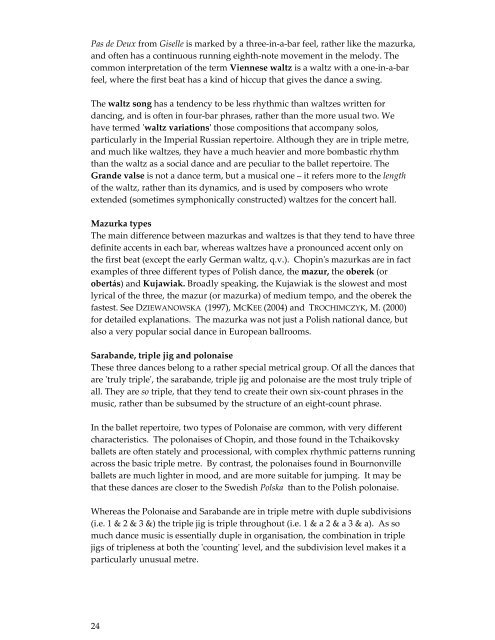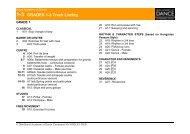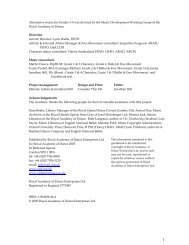Music in Focus guidebook to Alternative Music for Grades 1-3
Music in Focus guidebook to Alternative Music for Grades 1-3
Music in Focus guidebook to Alternative Music for Grades 1-3
You also want an ePaper? Increase the reach of your titles
YUMPU automatically turns print PDFs into web optimized ePapers that Google loves.
Pas de Deux from Giselle is marked by a three‐<strong>in</strong>‐a‐bar feel, rather like the mazurka,<br />
and often has a cont<strong>in</strong>uous runn<strong>in</strong>g eighth‐note movement <strong>in</strong> the melody. The<br />
common <strong>in</strong>terpretation of the term Viennese waltz is a waltz with a one‐<strong>in</strong>‐a‐bar<br />
feel, where the first beat has a k<strong>in</strong>d of hiccup that gives the dance a sw<strong>in</strong>g.<br />
The waltz song has a tendency <strong>to</strong> be less rhythmic than waltzes written <strong>for</strong><br />
danc<strong>in</strong>g, and is often <strong>in</strong> four‐bar phrases, rather than the more usual two. We<br />
have termed ʹwaltz variationsʹ those compositions that accompany solos,<br />
particularly <strong>in</strong> the Imperial Russian reper<strong>to</strong>ire. Although they are <strong>in</strong> triple metre,<br />
and much like waltzes, they have a much heavier and more bombastic rhythm<br />
than the waltz as a social dance and are peculiar <strong>to</strong> the ballet reper<strong>to</strong>ire. The<br />
Grande valse is not a dance term, but a musical one – it refers more <strong>to</strong> the length<br />
of the waltz, rather than its dynamics, and is used by composers who wrote<br />
extended (sometimes symphonically constructed) waltzes <strong>for</strong> the concert hall.<br />
Mazurka types<br />
The ma<strong>in</strong> difference between mazurkas and waltzes is that they tend <strong>to</strong> have three<br />
def<strong>in</strong>ite accents <strong>in</strong> each bar, whereas waltzes have a pronounced accent only on<br />
the first beat (except the early German waltz, q.v.). Chop<strong>in</strong>ʹs mazurkas are <strong>in</strong> fact<br />
examples of three different types of Polish dance, the mazur, the oberek (or<br />
obertás) and Kujawiak. Broadly speak<strong>in</strong>g, the Kujawiak is the slowest and most<br />
lyrical of the three, the mazur (or mazurka) of medium tempo, and the oberek the<br />
fastest. See DZIEWANOWSKA (1997), MCKEE (2004) and TROCHIMCZYK, M. (2000)<br />
<strong>for</strong> detailed explanations. The mazurka was not just a Polish national dance, but<br />
also a very popular social dance <strong>in</strong> European ballrooms.<br />
Sarabande, triple jig and polonaise<br />
These three dances belong <strong>to</strong> a rather special metrical group. Of all the dances that<br />
are ʹtruly tripleʹ, the sarabande, triple jig and polonaise are the most truly triple of<br />
all. They are so triple, that they tend <strong>to</strong> create their own six‐count phrases <strong>in</strong> the<br />
music, rather than be subsumed by the structure of an eight‐count phrase.<br />
In the ballet reper<strong>to</strong>ire, two types of Polonaise are common, with very different<br />
characteristics. The polonaises of Chop<strong>in</strong>, and those found <strong>in</strong> the Tchaikovsky<br />
ballets are often stately and processional, with complex rhythmic patterns runn<strong>in</strong>g<br />
across the basic triple metre. By contrast, the polonaises found <strong>in</strong> Bournonville<br />
ballets are much lighter <strong>in</strong> mood, and are more suitable <strong>for</strong> jump<strong>in</strong>g. It may be<br />
that these dances are closer <strong>to</strong> the Swedish Polska than <strong>to</strong> the Polish polonaise.<br />
Whereas the Polonaise and Sarabande are <strong>in</strong> triple metre with duple subdivisions<br />
(i.e. 1 & 2 & 3 &) the triple jig is triple throughout (i.e. 1 & a 2 & a 3 & a). As so<br />
much dance music is essentially duple <strong>in</strong> organisation, the comb<strong>in</strong>ation <strong>in</strong> triple<br />
jigs of tripleness at both the ʹcount<strong>in</strong>gʹ level, and the subdivision level makes it a<br />
particularly unusual metre.<br />
24











